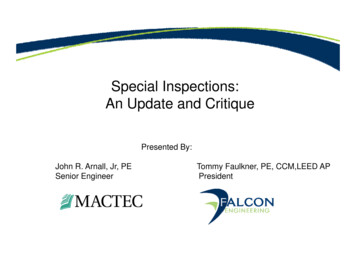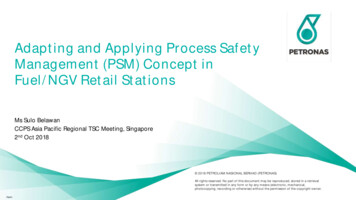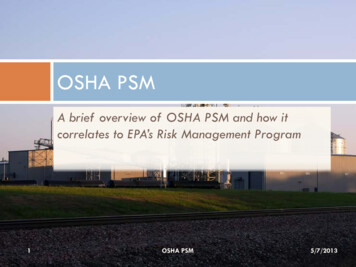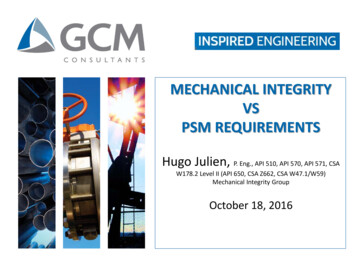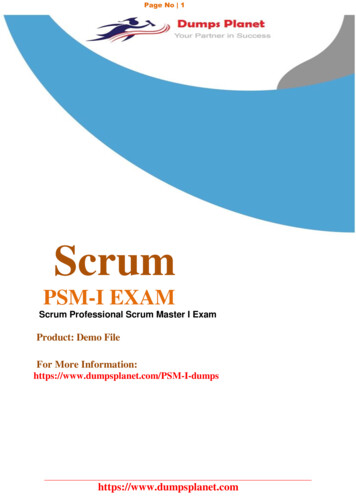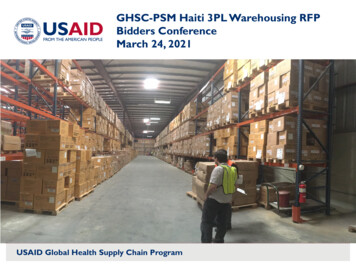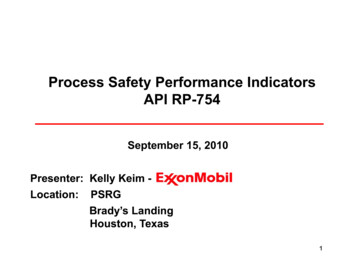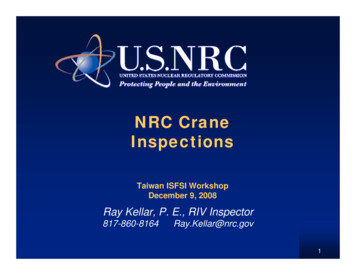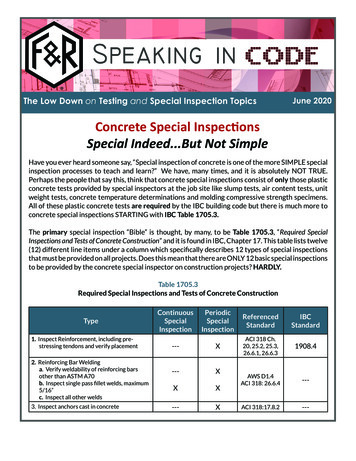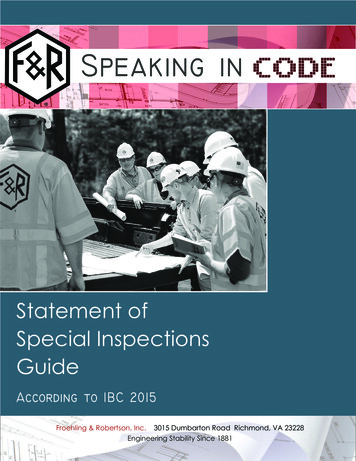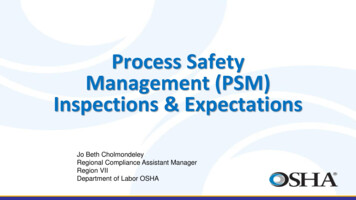
Transcription
Process SafetyManagement (PSM)Inspections & ExpectationsJo Beth CholmondeleyRegional Compliance Assistant ManagerRegion VIIDepartment of Labor OSHA
Process Safety Management(PSM)Enforcement ProcessBackground Performance Based Follows Recognized and Generally AcceptedGood Engineering Practices (RAGAGEP) A comprehensive analysis of a complexsafety program that is dependent on eachelement of the standard ( 14 elements)
OSHA 1910.119Process Safety ManagementFourteen Elements
What is the purpose of the PSM Management ofHighly Hazardous Chemicals?To control and prevent the consequences from a release of toxic,reactive, flammable or explosive chemicals. Highly Hazardous Chemicals (HHCs)are found in Appendix A of29 CFR 1910.119 Flammable liquids and gases in process above the ThresholdQuantity (TQ) of 10,000 pounds. Manufacturing of explosives and pyrotechnics.
History of PSM -NEP 1992 – PSM inspections– Program Quality Verification (CPL 02-02-045) Resource intensive 2007- Updated Refinery NEP– Still very resource intensive 2009 – Pilot NEP all PSM facilities– Different methodology Increase inspection / fewer resources 2011 – Implemented Pilot 2017 – Undated CPL (CPL 03-00-021)
Who is covered?OSHA JurisdictionRegion 7 Private-Sector and Federal Employers in Kansas,Nebraska, Missouri. Within Iowa, Private and Public Sectors are covered byState Plan OSHA and Federal Employers are covered byFederal OSHA.
Who is not covered? Not covered by the OSH Act: Self-employed; Immediate family members of farm employers that donot employ outside employees; and Workplace Hazards regulated by another Federalagency (for example, the Mine Safety and HealthAdministration, the Federal Aviation Administration, theCoast Guard).
How Does OSHA ScheduleInspections?Fatalities / CatastrophesUnprogrammed Complaints (Employee / General Public) Referral from state/local agencies/Media Incidents/ Accidents (RRI)Programmed Inspections PSM Covered Chemical Facilities NationalEmphasis Program (% of sites on list per region) Other Emphasis s/nep
What happens during an inspection? CredentialsOpening conferenceTour of the covered processEmployee and Managementinterviews Closing Conference
Opening Conference Verify covered facility– Does not fall under any exemptions Will ask for general documents- Will probably ask for more laterAttendees – Safety and Health Director, Process Safetymanager, person that can explain PSM program, union ifunion facility
Covered Process Threshold Quantities (TQs)are always expressed inpounds and are found in29 CFR 1910.119 Appendix A. A company may use, store,manufacture, handle or haveon-site movement of thechemicals.
Initial Documents 300 logs List of units– Maximum intended inventories Summary description of PSM programUnit process flow diagramContract or temporary employees?Emergency Action Plan
During the onsite inspectionDocument: Be prepared to provide written documentation such as butnot limited to: (provide as soon as possible) Recent flow diagrams of the covered process(es) Process safety information Maintenance records Mechanical integrity program, audit or complianceaudits and testing information Training OSHA has up to 6 months to complete the onsite inspectionand issue citations.
WalkaroundGet a general feel of the facility Select one or more units to do more complete evaluation Plain view violationsMay come back to some certain areas of the facility
GOOD HOUSEKEEPING PRACTICES . Engine Rooms must beclean and in order Equipment- vessels, pipes,valves, engines – labeledand clearly identified.
Watch out . RED FLAGS. Corrosion
Interview Employees (formal and informal)ManagementPSM personnelMaintenanceDynamic list of questions (not available)Sample questions – previous CPL
What to do during an OSHA inspection? Plan ahead and prepare– Do not procrastinate! Get familiarized with your coveredprocess(es) Organize & maintain all your informationavailable.
Enforcement Considerations Is the process covered by RAGAGEP sections ofPSM Multiple RAGAGEP apply– All acceptable if are as protective– But must pick one (can not mix and match) Use of inapplicable RAGAGEP can result in poorhazard control and can be grounds for citations. If no RAGAGEP still expected to provide adequateprotection - possible internal standards.
Definition of RAGAGEPCenter for Chemical Process Safety's (CCPS)Guidelines or Mechanical Integrity SystemsRAGAGEP: The basis for engineering, operation, or maintenanceactivities and are themselves based on establishedcodes, standards, published technical reports orrecommended practices (RP) or similar documents. RAGAGEP detail generally approved ways to performspecific engineering, inspection or mechanicalintegrity activities, such as fabricating a vessel,inspection a storage tank, or servicing a relief valve.
RAGAGEP in CFR 1910.119 – PSMEnforcement Where REGAGEP is directly referenced in PSM Standard– (d)(3)(ii): Employers must document that allequipment in PSM-covered processes complies withRAGAGEP– (j)(4)(ii): Inspections and tests are performedregarding mechanical integrity requirements inaccordance with RAGAGEP– (j)(4)(iii): Inspections and test frequency follows mfg.recommendations, good engineering practice, andmore frequent if indicated by operating experience.
Enforcement Considerations Mechanical Integrity: Correct deficienciesbefore further use or assure safe operationin the interim Updated RAGAGEP– Does not mandate employer upgradeequipment– OSHA expects employers to address issuesraised in a timely manner
OSHA Standards Related to Process Safety,Hazardous Chemicals, Emergency Response Process Safety Management, 29 CFR 1910.119 Hazardous Waste Operations and Emergency Response,1910.120 OSHA Hazard Communication Standard with the GloballyHarmonized System of Classification and Labeling of Chemicals(GHS), 1910.1200 Confined Spaces 29 CFR 1910.146 Emergency Action Plans 29 CFR 1910.38 Fire Prevention, 29 CFR Subpart L
Hazardous Waste and Emergency ResponseOperations OSHA Standard 1910.120Emergency Response Plan (ERP) 1910.120(q)(2)The emergency response plan must include the followingelements: Pre-emergency planning and coordination with outside parties, Personnel roles, lines of authority, training, and communication, Emergency recognition and prevention, Safe distances and places of refuge, Site security and control, Evacuation routes and procedures, Decontamination, Emergency medical treatment and first aid, Emergency alerting and response procedures, Critique of response and follow-up, and PPE and emergency equipment
OSHA Standards for Emergency PlanningOSHA standards can interface with HAZWOPER depending on the specific hazards on thesite and the work being performed. A few of these other standards may include:Subpart J – EnvironmentalSubpart E – Means of EgressControls37.Means of egress146.Permit-required confined spaces38.Employee emergency plans and fire 147.Control of hazardous energy sourcesprevention plans- Appendix Means ofSubpart K – Medical and First AidEgress151,Medical services and first aidSubpart I – Personal ProtectiveSubpart L – Fire ProtectionEquipment146.1910.155-156 Fire protection and fire132.Personal Protective Equipmentbrigades 1910.157-163 Firesuppression equipment133.Eye and face protection147.Fire detection systems148.Employee alarm systems Appendices134.Respiratory protectionA-E of Subpart L135.Head protection136.Foot protection138.Hand protection
OSHA Hazardous Communication Standard (HSC)29 CFR 1910.1200On September 30, 2009 OSHA issued a proposed rule to aligned the OSHA HazardCommunication Standard (HCS) with the Globally Harmonized System of Classification andLabeling of Chemicals (GHS) On March 20, 2012: OSHA issued the Final Rule aligning the HCS to the GHS. What you need to do and when: Chemical users: Continue to update safety data sheets when new ones becomeavailable, provide training on the new label elements and update hazardcommunication programs if new hazards are identified. Chemical Producers: Review hazard information for all chemicals produced orimported, classify chemicals according to the new classification criteria, and updateEffective CompletionRequirement(s)Wholabels Dateand safetydata sheets.December 1, 2013Train employees on the new label elements and SDS format.EmployersJune 1, 2015*Comply with all modified provisions of this final rule, except:Chemical manufacturers, importers,distributors and employersDecember 1, 2015Distributors may ship products labeled by manufacturers underthe old system until December 1, 2015.June 1, 2016Update alternative workplace labeling and hazard communication Employersprogram as necessary, and provide additional employee trainingfor newly identified physical or health hazards.Transition PeriodComply with either 29 CFR 1910.1200 (this final standard), or thecurrent standard, or both.All chemical manufacturers, importers,distributors and employers
NEW
Retail Exemption29 CFR 1910.119(a)(2)(i)New Memo – April 30, 2018 OSHA will not issue citations under PSM forNAICS codes– 424510 – Grain & Field Bean Merchant Wholesalers– 424590 – Other Farm Product Raw materialMerchant Wholesalers– 424910 – Farm Supplies Merchant Wholesalers BUT, must continue to comply with otherapplicable OSHA standards– Anhydrous ammonia, HAZWOPER, HAZCOM, etc.
Retail Exemption29 CFR 1910.119(a)(2)(i)New Memo – April 30, 2018 For all other industries subject to PSM coverage, CSHO’sshould exercise enforcement discretion in accordancewith the following explanation from the preamble to thePSM standard: With respect to the exclusion of retail facilities OSHA believedthat such facilities did not present the same degree of hazard toemployees as other workplaces covered by the proposal.Therefore, OSHA should not require a comprehensive PSMsystem in addition to other applicable OSHA standardsaddressing flammable & combustible liquids, compressedgases, hazard communication, etc., for retail facilities
Reference DocumentsPSM Covered Chemical Facilities National EmphasisProgram – CPL 03-00-021 (January 17, 2017)PSM Covered Concentrations Policy (June 8, 2015)PSM RAGAGEP Policy (May, 11, 2016)OSHA Response to Significant Events of Potentially CatastrophicConsequences – CPL 02-00-094 (July 22,1991)
Questions?Now is the time to ASK Jo Beth 9
Therefore, OSHA should not require a comprehensive PSM system in addition to other applicable OSHA standards addressing flammable & combustible liquids, compressed
